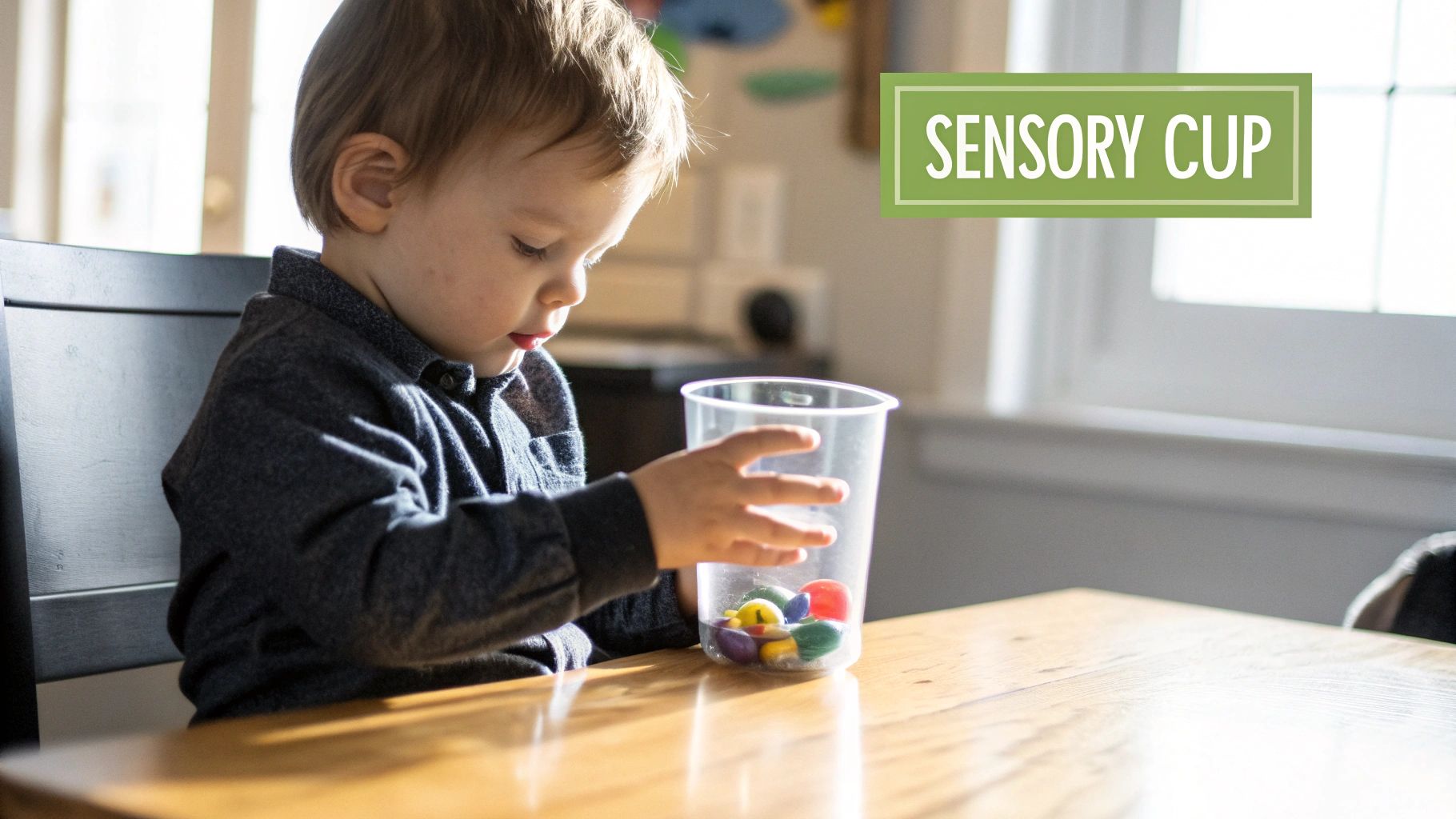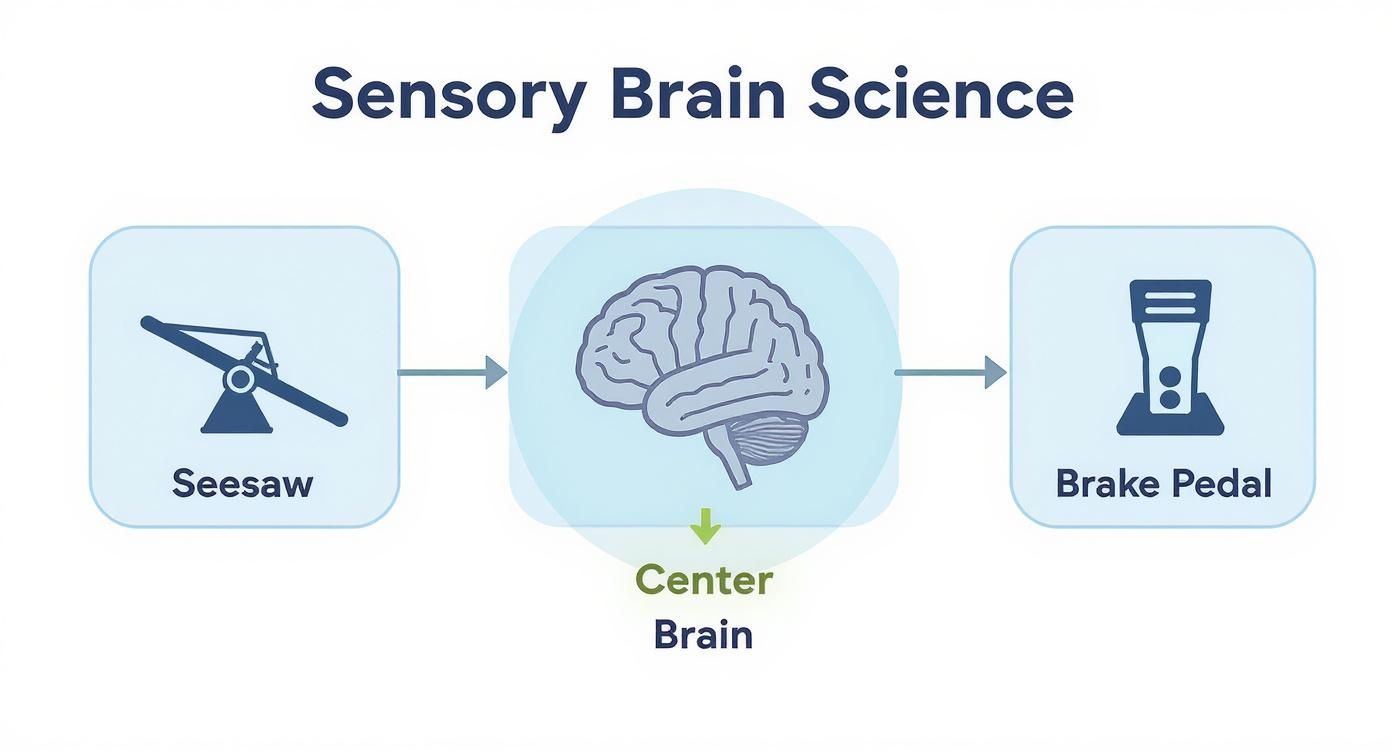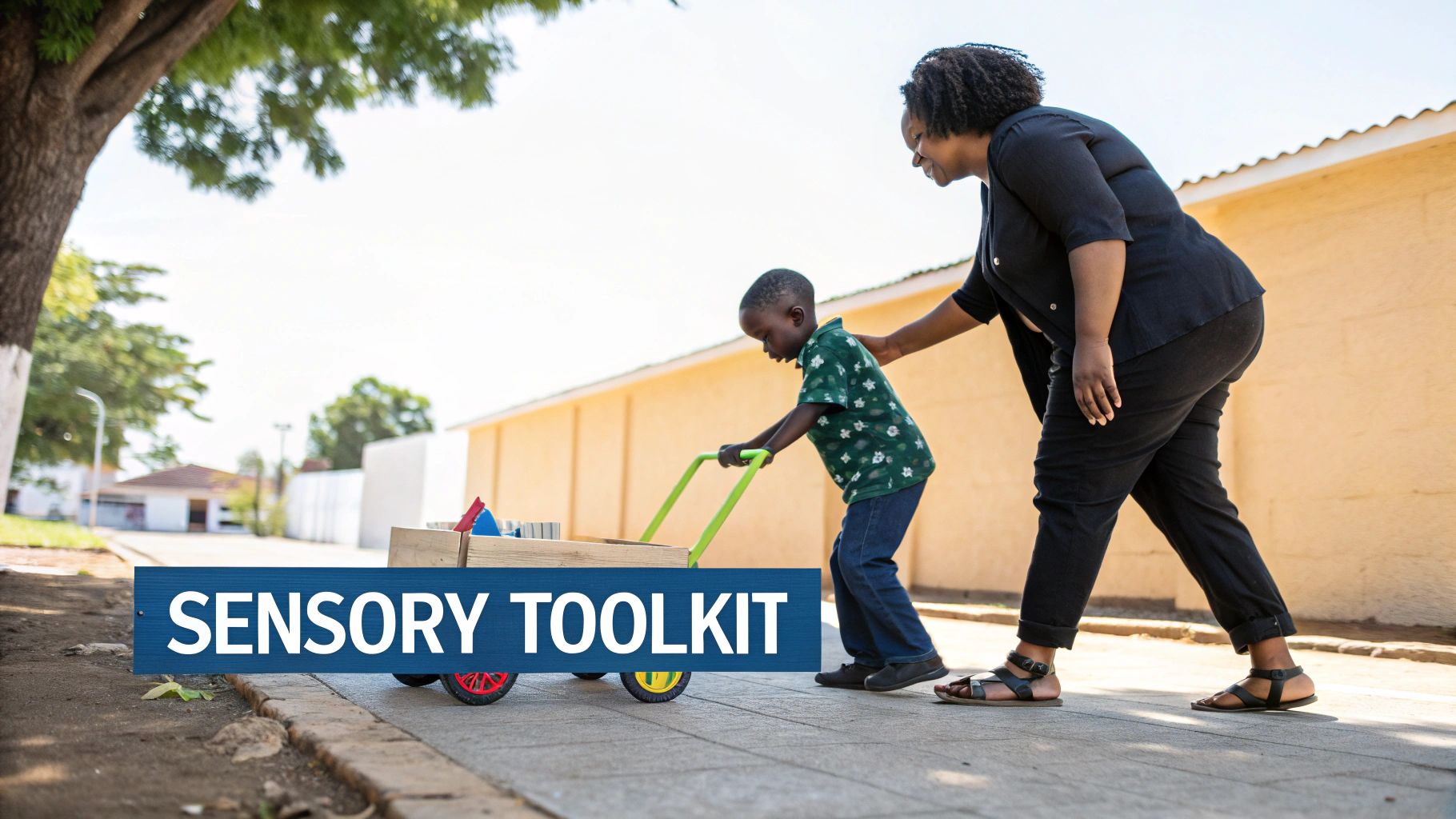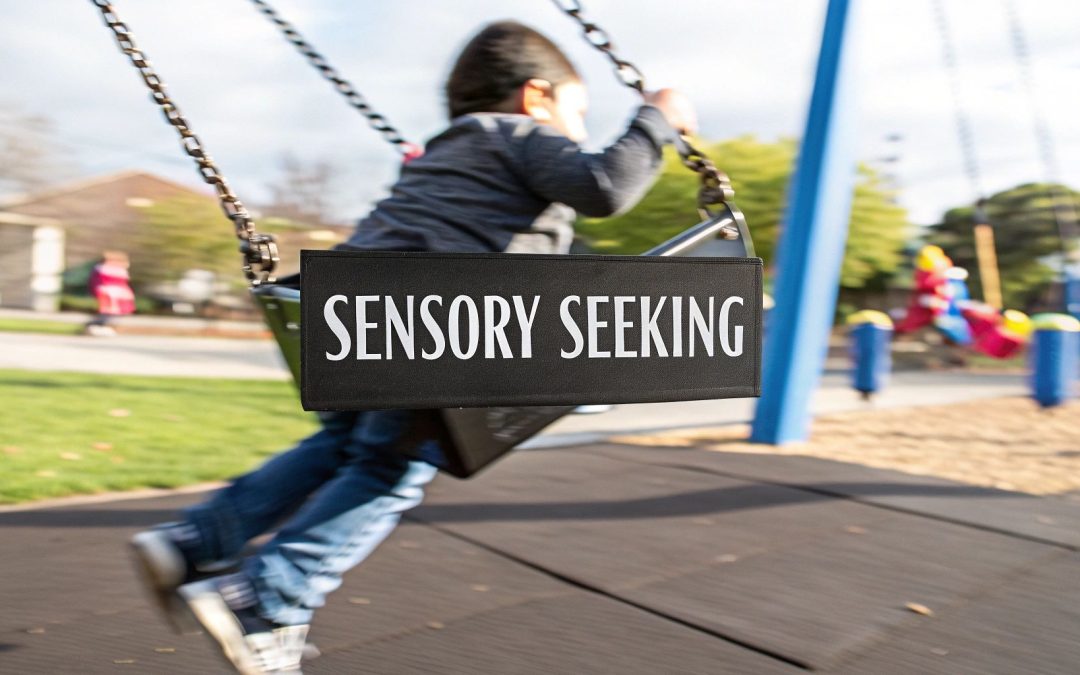Ever notice how some kids are just always on? They're the ones constantly spinning in circles, crashing into the sofa cushions, or making loud, repetitive noises. These aren't just random acts of a high-energy kid; they're classic examples of sensory seeking behaviors.
This isn't defiance. Far from it. It’s a child's built-in, intuitive drive to get the specific sensory feedback their brain and nervous system are desperately craving to feel calm, organized, and "just right."
Why Your Child Is Always on the Go

Does your child seem to have an engine that just won't quit? Maybe they chew on their shirt collar, give hugs that feel more like a full-body squeeze, or treat every piece of furniture like a personal climbing wall. This isn't simply "kids being kids"—it's often a clear signal of sensory seeking.
To really get it, picture a child's nervous system having a "sensory cup."
Some kids are born with really big cups. They need a ton of sensory input just to feel full, balanced, and regulated. A quiet room or some gentle playtime might barely put a drop in their cup. That’s why they instinctively seek out these intense experiences—they're actively trying to fill their own cup so they can feel comfortable in their own skin.
Beyond the Five Senses
When we talk about senses, our minds usually jump to sight, sound, smell, taste, and touch. But there are three more internal senses that are absolutely crucial for understanding a sensory seeker. These hidden senses are often the real drivers behind a child's need for constant, intense physical activity.
For sensory seekers, two of these are especially important:
- The Vestibular System: Tucked away in the inner ear, this is our body's center for movement and balance. A kid who is always spinning, swinging, or hanging upside down is giving their vestibular system the input it craves.
- The Proprioceptive System: This is our sense of body awareness, and it's fueled by receptors in our muscles and joints. Big movements like crashing into pillows, stomping their feet, or pushing heavy toys provide powerful proprioceptive feedback.
Think of these behaviors as a form of communication. Your child isn't trying to be disruptive; their body is literally telling you what it needs to function properly. The constant motion from vestibular input and the deep pressure from proprioceptive activities help organize their brain and bring a sense of calm to their nervous system.
When a child engages in sensory seeking behaviors, they are essentially self-prescribing the neurological "food" their brain needs to focus, learn, and regulate emotions. It's a biological drive, not a behavioral choice.
Understanding this completely reframes the situation. It shifts from a discipline problem to an opportunity for support. Once you recognize these actions as signals of an unmet need, you can start providing the right kind of input in a safe, structured way. This perspective is foundational for anyone wanting to learn more about what sensory processing disorder is and how it shows up. It moves us from a place of frustration to one of compassion and, ultimately, effective action.
The Brain Science Behind Sensory Seeking
To really get what’s happening with sensory seeking behaviors, we have to look under the hood at the incredible wiring of the brain and nervous system. These actions aren't just random quirks; they're driven by a deep, biological need for certain kinds of input to find a sense of balance. At the heart of it all is a concept called the neural threshold—basically, the amount of sensory information the brain needs before it even notices and responds.
Picture a neurological seesaw inside your child. For a kid with a high neural threshold (a classic sensory seeker), that seesaw is tipped way over to one side. They need a massive amount of sensory input piled on the other side just to get it level. A gentle push on a swing or a quiet coloring session barely moves the needle. They need intense, prolonged, and frequent stimulation to feel "just right."
The Gas Pedal and The Brake Pedal
This constant hunt for input is tied directly to the two main gears of our autonomic nervous system: the sympathetic and parasympathetic systems. You can think of them as the body's gas pedal and brake pedal.
- The Sympathetic System (Gas Pedal): This is our "fight or flight" response. For a sensory seeker, this system is often stuck in overdrive, leading to a state of high alert, restlessness, and disorganization.
- The Parasympathetic System (Brake Pedal): This is our "rest and digest" mode. It's what allows us to feel calm, focused, and regulated.
This is where the magic happens. Intense sensory activities, especially those involving movement (vestibular) and deep pressure (proprioceptive), are powerful ways to activate the parasympathetic system. When your child crashes into a pile of cushions or spins in circles, they are instinctively slamming on their own brake pedal to calm down that revved-up gas pedal. This neurological reset helps them shift from being completely overwhelmed to a state where they can actually focus, learn, and connect.
A child’s sensory seeking behavior is their brain's brilliant, unconscious strategy to find equilibrium. The loud noises, constant motion, and tight hugs are all attempts to regulate a nervous system that is out of sync.
Why Biology Is Not a Choice
It's so important to remember that these neurological drivers aren't a matter of willpower or bad behavior. Research has consistently shown a strong link between sensory processing differences and developmental conditions like Autism Spectrum Disorder (ASD) and ADHD.
In fact, for many children with these diagnoses, sensory seeking is a core part of their experience. About 74% of children with ASD have documented sensory processing differences, which really shows how fundamental these needs are.
This biological foundation is exactly why telling a child to "stop fidgeting" or "calm down" almost never works. Their brain simply isn't receiving or processing sensory information in a typical way. Their actions are a necessary adaptation to their unique neurology. Getting familiar with the different stages of sensorimotor development can offer even more insight into how these essential brain-body connections are built right from infancy.
When we start to see these behaviors through a neurological lens, we can shift our perspective from frustration to fascination. We stop seeing a child who is trying to be difficult and start seeing one who is actively working to manage their own brain and body in the only way they know how. This understanding is the first—and most critical—step toward providing truly effective, compassionate support.
How to Recognize Sensory Seeking in Your Child
Is it just a burst of kid energy, or is it something more? It can be tricky to tell the difference between typical high-energy play and a true pattern of sensory seeking behaviors. But once you know the signs, things start to click into place.
These behaviors aren't random. They are intentional, purposeful actions your child uses to feed their nervous system the exact input it's craving to feel organized, calm, and regulated. Recognizing this is the first real step toward helping them. Instead of seeing a "disruptive" or "difficult" child, you'll start to see a child communicating a deep neurological need.
This infographic does a great job of visualizing what's happening under the surface, connecting the brain’s quest for balance with the nervous system's "gas pedal" and "brake pedal."

As the model shows, that intense sensory input acts like the "brake," helping to pump the brakes on an overstimulated system and get that "seesaw" back into balance.
Clues in Movement and Body Awareness
Two of the most powerful sensory systems driving a child’s behavior are the vestibular (our sense of balance and movement) and proprioceptive (our sense of body awareness) systems. A kiddo seeking input for these systems is often the one in constant, forceful motion.
This isn't just about burning off energy; it's about getting the intense feedback their brain needs to feel grounded. They are literally using movement and pressure to regulate themselves.
To make this clearer, we've broken down some of the most common sensory seeking behaviors and connected them to the specific sensory system they're trying to stimulate. This helps you get to the "why" behind the action.
Identifying Sensory Seeking Behaviors by System
| Sensory System | Common Behaviors Observed | What the Child is Seeking |
|---|---|---|
| Vestibular | – Insatiable need for swinging, higher and faster – Spinning in circles without getting dizzy – Hanging upside down off furniture – Constant rocking or swaying |
Intense movement input to understand where their body is in space. |
| Proprioceptive | – Crashing into furniture, pillows, or people – Stomping feet or jumping hard off things – Giving overly tight hugs or wrestling forcefully – Pushing or lifting heavy objects |
Deep pressure and feedback to muscles and joints for a grounding, calming effect. |
| Oral Motor | – Chewing on shirt collars, pencils, or toys – Preferring very crunchy or chewy foods – Making repetitive noises with their mouth |
Strong, regulating input through the jaw. |
| Auditory | – Making loud, repetitive sounds with voice or objects – Turning up the TV or music volume very high – Enjoying loud, busy environments |
Intense sound input to organize their auditory system. |
| Tactile | – A constant need to touch everything and everyone – Loving messy play (sand, paint, slime) – Preferring very tight-fitting clothes or blankets |
Consistent and varied touch sensations on their skin. |
| Visual | – Fascination with bright, flashing, or spinning lights – Holding objects very close to their eyes – Watching fast-paced cartoons or videos |
Strong visual stimulation to engage their visual processing system. |
By looking at these patterns, you can start to build a sensory profile for your child. You're no longer guessing—you're decoding their behavior.
Observing Oral, Auditory, and Other Seeking Behaviors
While big movements are easy to spot, sensory seeking shows up in other ways that can be mistaken for simple bad habits. For instance, a child seeking oral input isn't just being destructive when they chew on their shirt collar; they are trying to get that powerful, organizing feedback through their jaw.
Sensory seeking behaviors are a child’s external attempt to solve an internal problem. The constant motion, loud noises, and intense physical contact are all strategies to achieve neurological regulation.
This drive for sensory input is especially common in children with developmental differences. One large-scale study that monitored over 25,000 children found that approximately 74% of autistic children had documented sensory processing differences. This really highlights how central these behaviors are to their experience. You can read the full findings on how sensory features present in childhood.
When you start categorizing these behaviors, you can see a clear map of your child’s unique sensory needs. This clarity turns confusion into a practical roadmap, empowering you to respond with targeted, effective support that truly meets them where they are.
The Consequences of Unmet Sensory Needs
When a child's deep, neurological need for sensory input goes unanswered, the effects ripple through every part of their life. These aren't just minor frustrations—unmet sensory needs can throw up some serious roadblocks to their emotional stability, learning, and social development. What often looks like defiance is actually desperation.
Imagine a child whose body is just screaming for movement and deep pressure. In a classroom, they can't exactly get up and crash into a pile of cushions. Instead, you might see them constantly rocking in their chair, tapping their pencil, or kicking their legs under the desk. To someone who doesn't understand what's going on, this child gets labeled "disruptive," "unfocused," or even "disrespectful."
But this fidgeting isn't a choice. It's a frantic, subconscious attempt to give their nervous system the input it needs just to stay regulated enough to listen and learn. When these attempts are constantly corrected or punished, the child is left in a state of neurological disorganization, making focus feel next to impossible.
The Impact on Emotional Regulation and Behavior
A child whose sensory cup is always empty is a child living in a constant state of dysregulation. This internal chaos makes managing emotions incredibly difficult. Small disappointments can trigger huge meltdowns, and minor frustrations can quickly spiral into intense outbursts of anger.
This happens because their nervous system is already redlining, with no buffer left to handle everyday stressors. The child isn't "overreacting" on purpose; they simply don't have the internal balance needed to process their feelings in a measured way.
When sensory seeking behaviors are misunderstood, a child's attempt to self-regulate can be misinterpreted as aggression or defiance. This misunderstanding creates a cycle of frustration for both the child and their caregivers.
Over time, this constant struggle can lead to more significant challenges. We see from the research that children with sensory processing differences often face higher risks for both internalizing behaviors (like anxiety) and externalizing behaviors (like aggression).
Studies on sensory processing disorder (SPD), which affects between 5% and 16% of school-aged children, back this up. Kids with sensory over-responsivity, a related condition, are reported to have a four times higher likelihood of internalizing problems and a three times higher likelihood of externalizing them. You can dive deeper into the latest research findings on sensory health to learn more.
Barriers to Social Skills and Learning
The consequences don't stop at emotional health. A dysregulated child simply can't effectively engage with their friends or absorb new information in the classroom.
-
Social Challenges: Friendships require give-and-take, an awareness of personal space, and calm participation. A child seeking intense proprioceptive input might give hugs that are way too tight or play too roughly, unintentionally pushing away friends who don't understand their needs.
-
Learning Obstacles: In the classroom, a child whose brain is focused on getting sensory input is a child who isn't fully available for learning. All their cognitive resources are being spent just trying to find a baseline of regulation, leaving very little capacity for listening to the teacher, finishing assignments, or joining in group activities.
Meeting these needs isn't about indulging a child—it’s about providing the essential foundation for their overall well-being. Proactive support is critical for helping them learn, form meaningful friendships, and feel secure and capable in their world.
Practical Ways to Support a Sensory Seeker
Understanding your child's sensory needs is a huge first step. But the real magic happens when you start putting that knowledge into action. This is your hands-on toolkit for channeling their intense energy into safe, productive, and deeply regulating activities.
Instead of trying to stop the behaviors, our goal is to provide healthier, more effective ways for them to get the input they crave.

This proactive approach is often called creating a "sensory diet." And don't worry, it has nothing to do with food! A sensory diet is a personalized daily menu of activities designed to give your child a consistent, predictable stream of the sensory input their nervous system needs to stay balanced.
What Is a Sensory Diet
Think of a sensory diet like regular, healthy meals for the nervous system. You wouldn't wait until you're starving to eat, right? In the same way, we don't want to wait until a child is completely dysregulated and crashing into furniture—which is basically being "hangry" for sensory input.
A sensory diet provides small, strategic "sensory snacks" throughout the day. This approach helps fill their sensory cup proactively, keeping their nervous system in a state of calm alertness so they feel organized and ready to learn, play, and connect.
A sensory diet isn't about adding more to your plate. It's about intentionally weaving specific activities into your existing daily routines to meet your child's neurological needs before they become overwhelming.
The best sensory diets are simple and built around a child’s natural routines—maybe before school, after a long car ride, or during homework time. Let's break down some of the most effective types of sensory snacks you can start using today.
Heavy Work Activities for Grounding
Heavy work is any activity that involves pushing, pulling, or carrying something with resistance. These actions engage the muscles and joints, delivering powerful proprioceptive input that is incredibly calming and organizing for the brain.
You don't need any special equipment for this; many heavy work activities are just regular household chores and everyday tasks.
- Grocery Helper: Have your child help carry in grocery bags or push the shopping cart.
- Laundry Assistant: Let them help push the laundry basket or carry it to the laundry room.
- Furniture Mover: When it's time to clean, ask them to help push chairs back to the table or slide a box of toys across the room.
- Gardening Partner: Tasks like digging in the dirt, pulling weeds, or carrying a small watering can are fantastic heavy work.
These simple jobs provide the deep pressure feedback a sensory seeker's body is often craving, helping them feel more grounded and centered.
Movement Breaks for Regulation
For a child seeking vestibular input, movement isn't just fun—it's essential for their brain. Structured movement breaks provide this input in a safe, controlled way, helping to organize their brain and sharpen their focus.
Even short, five-minute bursts of intense movement can completely reset a child's nervous system, especially before tasks that require them to sit still.
- Trampoline Time: A few minutes of jumping on a mini-trampoline can work wonders.
- Swinging: If you have access to a swing, this provides consistent and rhythmic vestibular input.
- Animal Walks: Get creative! Encourage them to do bear crawls, crab walks, or frog jumps across a room.
- Spinning: Controlled spinning in an office chair for 10-15 seconds in each direction can satisfy a powerful need.
Oral Motor Tools for Focus
Many sensory seekers have an intense need for oral input. Chewing provides strong, organizing feedback to the jaw, which has a direct line to the parts of the brain responsible for regulation. Instead of chewing on shirt collars or pencils, we can offer safe and appropriate alternatives.
These tools can be especially helpful during homework, car rides, or other quiet times when a child might feel restless and need to fidget.
- Crunchy Snacks: Offer foods with a lot of texture, like carrots, apple slices, pretzels, or nuts.
- Chewy Jewelry: Silicone necklaces or bracelets designed for chewing can be a discreet and effective tool for school.
- Thick Drinks: Drinking a thick smoothie or yogurt through a straw requires a lot of oral motor work and is very satisfying.
These are just a few ideas to get you started, but the most effective strategies are always the ones tailored to your child’s specific needs. For more advanced support, exploring sensory processing disorder therapy with a qualified professional can provide a personalized plan to help your child thrive.
By meeting these sensory seeking behaviors with understanding and proactive support, you empower your child with the tools they need to feel good in their own body.
Common Questions About Sensory Seeking
Diving into the world of sensory needs can feel like learning a whole new language. As you start connecting the dots between your child's behavior and their neurological wiring, it’s completely normal to have a ton of questions. We’ve put together some clear, straightforward answers to the questions we hear most often from parents.
Our goal is to give you practical insights that build your confidence. The more you understand, the better equipped you'll be to give your child exactly what they need to thrive.
Is Sensory Seeking a Sign of Autism or ADHD?
This is easily one of the most common questions we get, and it makes perfect sense. While intense sensory seeking is a classic trait in many kids with an Autism (ASD) or ADHD diagnosis, it’s definitely not exclusive to them. Plenty of neurotypical children have sensory seeking tendencies as a natural part of growing up.
The real difference often comes down to the intensity, frequency, and impact on daily life. If the behaviors are so constant that they get in the way of learning, make it hard to socialize, or create safety risks, that’s a strong sign a professional evaluation could be helpful—regardless of any specific diagnosis.
It's also worth knowing just how common these sensory differences are. Globally, research suggests that sensory processing challenges may affect about 21.5% of typically developing children. For kids with an ASD diagnosis, that number jumps significantly, with rates between 69% and 95%. You can read more about these childhood sensory processing findings to see the bigger picture.
How Is Sensory Seeking Different From Sensory Avoiding?
It's helpful to think of sensory seeking and sensory avoiding as two sides of the same coin. Both are about how a child's unique nervous system is wired.
-
A sensory seeker has a high neurological threshold. You can imagine their "sensory cup" is huge, and it takes a ton of input to fill it up and help them feel regulated. They're the kids who actively chase after intense sensations—loud sounds, fast spinning, and big bear hugs.
-
A sensory avoider has a low neurological threshold. Their cup is tiny and overflows with just a little bit of input. They are often highly sensitive to their environment and can find bright lights, scratchy tags on clothes, or loud noises genuinely uncomfortable or even painful.
It's not always one or the other. It's incredibly common for a child to be a sensory seeker in one area (like constantly needing to jump and crash) but a sensory avoider in another (like being an extremely picky eater who can't stand certain food textures).
This kind of mixed profile is exactly why paying close attention to your child's specific actions is the key to understanding their complete sensory picture.
When Should I Seek Professional Help for My Child?
Always trust your gut. As a parent, you know your child better than anyone. It’s time to reach out for professional help when your child’s sensory needs are getting in the way of them being able to function safely and happily.
Think about getting support if you’re noticing things like:
- Safety Concerns: The behaviors are becoming dangerous, like climbing tall furniture, jumping from high places, or playing too rough with other kids.
- Learning Disruptions: Their need for constant movement makes it almost impossible to sit still, focus, and learn in a classroom.
- Social Challenges: Their sensory needs are preventing them from making friends, joining in group activities, or enjoying family outings.
A great first step is connecting with an occupational therapist (OT) who specializes in sensory integration. They can do a full evaluation and create a personalized plan to help your child get the input they need to succeed.
Can a Child Outgrow Sensory Seeking Behaviors?
A child’s sensory profile is a core part of who they are, much like their personality. So, instead of thinking they'll "outgrow" it, it’s more accurate to say they learn to manage and adapt their needs as they mature.
The goal isn't to get rid of these sensory needs. It's to teach your child healthier, safer, and more socially appropriate ways to meet them. With the right tools and strategies, they learn to self-regulate more effectively on their own.
For example, a little kid who constantly crashes into the sofa for that deep pressure input might grow into a teenager who gets that same calming feedback from lifting weights, playing football, or doing martial arts. The underlying need is still there, but how they express it has matured. By giving them supportive outlets, you’re handing them tools for self-regulation that will last a lifetime.
At First Steps Chiropractic, we specialize in getting to the root neurological causes of sensory challenges. Our gentle, neuro-tonal approach helps bring the nervous system back into balance, empowering kids to better process their world and truly thrive. Learn more about our specialized care by visiting us at https://firststepschiropractic.com.

